*Disclaimer* I have found shifting my mindset and working on my emotional health to be beneficial practices in my life, however, it's important to acknowledge mindsets can only do so much - a shift in how you think will not solve issues of: food scarcity, access to health care, housing, support for disabilities, toxic and/or abusive relationships, racism, and other circumstances that are bigger than a thought re-frame. The following suggestions are not meant as all encompassing solutions, but rather a potentially helpful starting place for people who struggle with processing their emotions, observing their thoughts, and finding balance for themselves internally.
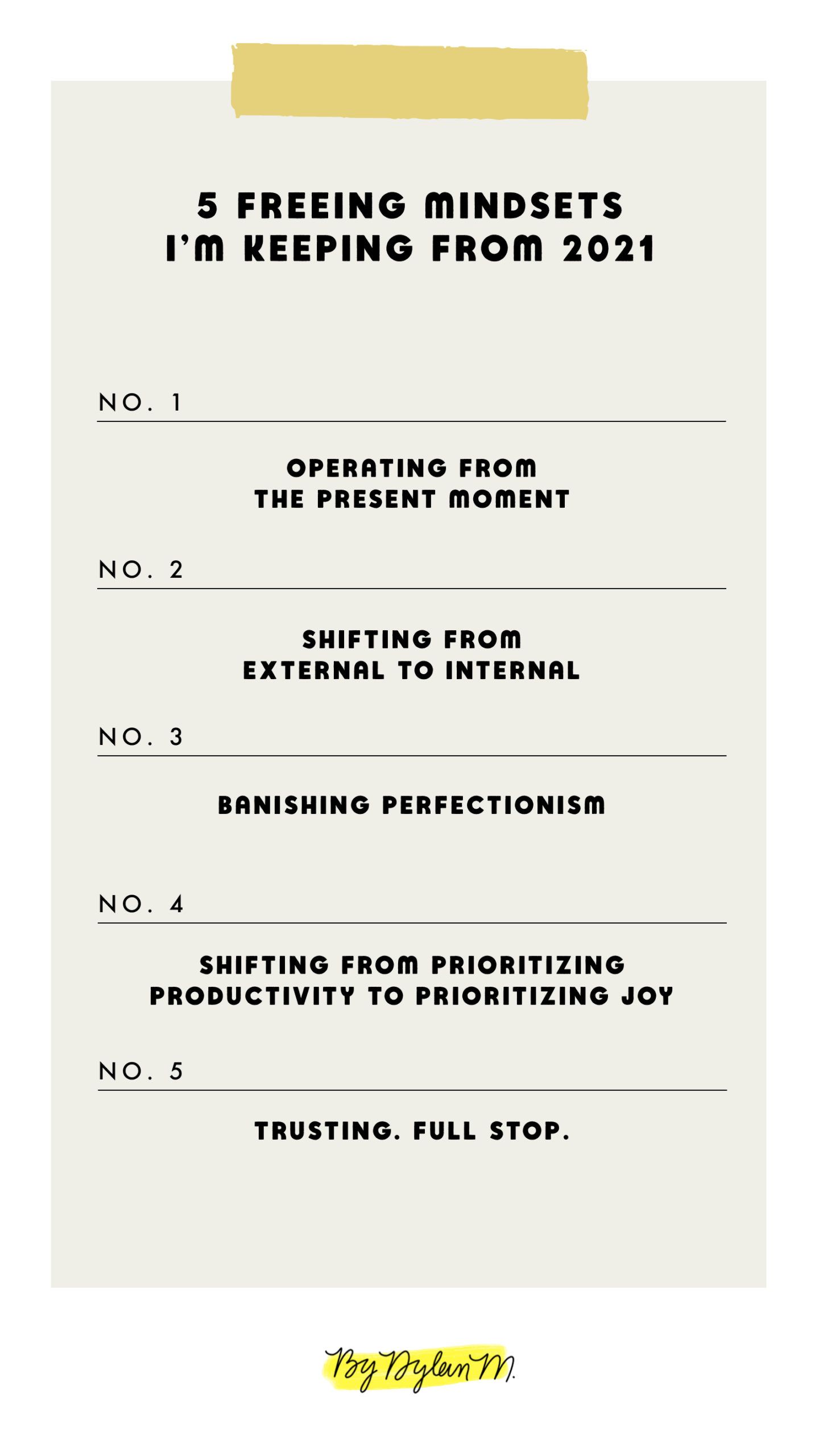
These are the nuggets of gold, the tiny but solid gems, and the pearls of wisdom I collected in 2021 and wish to carry forward:
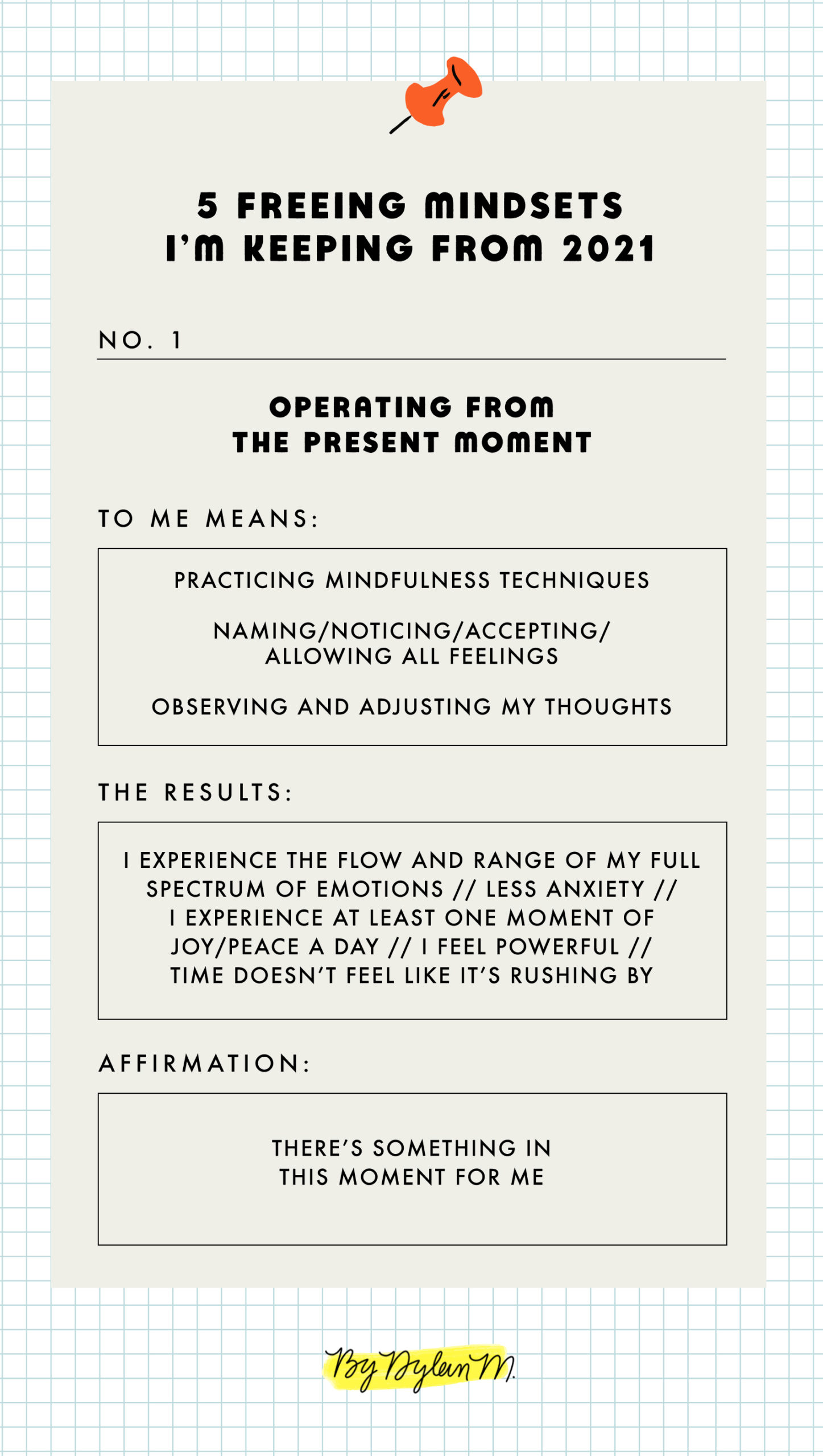
1. Operating from the present moment
To me means:
- Using mindfulness techniques to practice being present in the real, actual moment (as opposed to in my brain reflecting on the past or considering the future)
- Naming, noticing, accepting, and allowing all feelings (as opposed to ignoring, shaming, judging, or forcing past them)
- Naming and noticing thoughts, getting curious about them, and changing them when they aren’t serving a purpose (as opposed to living blindly from unexamined thoughts and beliefs)
These can look like:
- Mindfulness technique: Naming 5 things I can see, 4 things I can feel, 3 things I can hear, 2 things I can smell, 1 thing I can taste RIGHT NOW (this exercise is the shortest route for me from brain prison to present moment, as my brain can’t help but begin the easy task of naming)
- Feelings: When I’m having a bad/hard/rough/uncomfortable day, I no longer shame myself for all the reasons I *shouldn’t* feel that way (but people have it worse than me! but I’m safe! but I’m capable! but the sun is shining and life is short!), instead I name the feeling (using this feelings wheel), say ‘anxious’, and then make a list for why it makes PERFECT and total sense that I’m feeling that way. I notice and allow the feeling. It passes naturally.
- Thoughts: Let’s say I’m procrastinating beginning a task that only hours before I had decided was the best use of my time. In checking in with my thoughts I notice I keep saying to myself “I better perform well on this project or else…”. This thought is providing unnecessary pressure – of course I want to perform well, but the threatening thought of “I better..or else” isn’t serving me anything but more moments of avoiding my work. I decide I want to feel more relaxed about beginning the project, and therefore the thought “I always find my way once I get started” might be a better replacement thought, as that sentence gives me a feeling of ease, confidence, and low pressure to be perfect. The thought “I better…or else” distracted me with fear and took me out of the moment, “I always find my way” brings me back here, where I can find my way.
The result:
- I experience the full spectrum of my emotions (less things get pent up, less unnecessary suffering)
- I have considerably less circumstantial anxiety and virtually no generalized anxiety. I’m not afraid of the future.
- I experience joy every single day. Please note that I’m not saying I ONLY experience joy – this is not toxic positivity in hiding – but I do truly experience at least one moment of joy and/or peace each day. When I was living in my head, storming about the future or lamenting about the past, I simply couldn’t appreciate the joy of a hummingbird at the feeder, or the jolt of a great song coming on shuffle, or the warm comfort of the garage door opening and my loved one safely returning home.
- I feel powerful in my life – I’m not the victim of my circumstances or my own thoughts
- Life doesn’t feel like it’s rushing by. I’ll hear friends or family go “Can you believe it’s already the end of September?” and I’ll think to myself “Yep, I’ve been here for every day of September.”
Related affirmation:
- There’s something for me in this moment
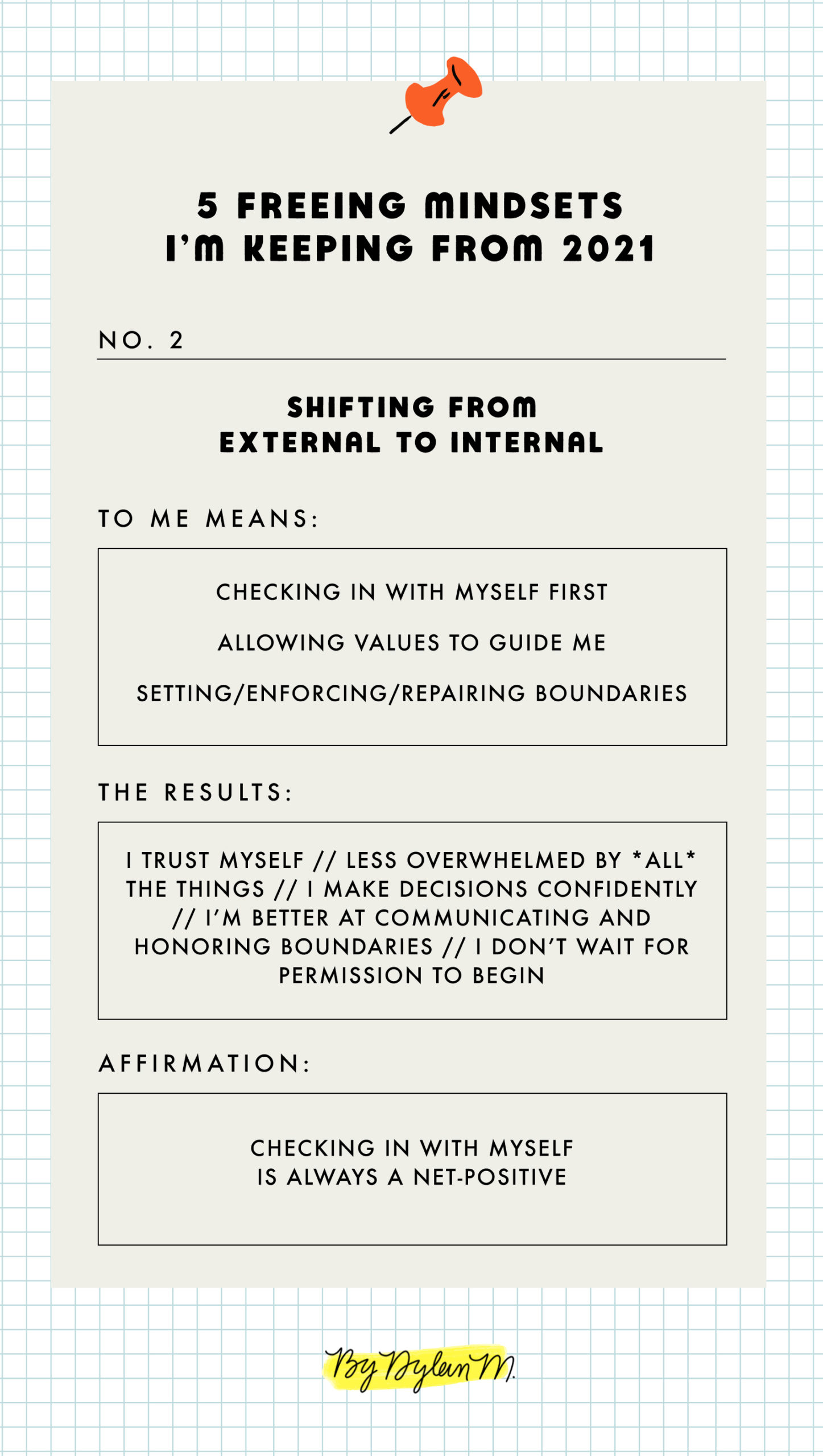
2. Shifting from external to internal
To me means:
- Asking/checking in with myself before checking in with others (and Google)
- Naming, honoring, prioritizing, and allowing my values to guide my decision making
- Naming, setting, protecting, and repairing boundaries
These can look like:
- Asking myself first: instead of polling my audience to see what they want to learn from me on Skillshare, or Googling what topics fellow creatives are searching for, I ask myself what I’m interested in teaching. Instead of Googling “how to grow an Instagram audience,” I’ll first ask myself “what do I feel I could be doing better in regards to social media?” It doesn’t mean I never Google or ask for help, but I do check in first to see what questions I’m even asking, and further to see if I already have a hunch on where to start.
- Values: I’ve learned that I value my free time and creative expression more than I value the glory and accolades of a shiny brand-name collaboration (it honestly took quite a while for me to realize this for myself), so now when commissions come across for consideration, I look at my available time, the creative problem I’m being hired to solve, and think about what other creative/free time endeavors I’ll have to say no to in order to say yes to the project in question – if my schedule allows for it, if I’m excited about the creative problem I’m being hired to solve, and if there’s nothing else on my creative plate that I’d rather spend my time on (paid or not), I say yes. Before, I basically said yes to any and all projects by default, unless I was already crazy overloaded and simply couldn’t take on another project, neither of which are decisions made by considering my values. In some seasons money is needed more than joy and free time, and I make decisions accordingly.
- Boundaries: Capitalism and our society have dictated that 9-5 are reasonable working hours, but my own flow is not aligned with that. I honor my own energy flow, which sometimes requires me to set boundaries with myself (for ex. “Only ten more minutes of reading, as I can feel my creative energy welling up”) and others (for ex. my fiance works 9-5, and I’ve had to communicate expectations around not disturbing me/assuming I’m done with work just because he is). Another example is scrutinizing outside ideas, ‘shoulds’, tips, and recommendations before blindly internalizing them (like “you should sell original artwork!”, thank you for the enthusiasm but nope, not for me right now, and that’s a-ok).
The result:
- I trust myself. a lot. I feel so capable at handling my life. I don’t feel overwhelmed by the constant barrage of ideas, ideologies, trends, vocations, hacks, threats, or anything else the world tries to distract me with on any given day. I hear it, I see it, and then I check in to see what I want to do with it from there
- I make decisions, even big and unsure ones, confidently, and pretty quickly too. Where my brain can rationalize and argue all sides forever, my intuition and values are more reliable, and provide a better filter than my brain trying to calculate based on information alone.
- I’m better at communicating my boundaries and expectations, as well as honoring others boundaries
- I don’t wait for permission, perceived or otherwise, to begin.
Related affirmations:
- Checking in with myself is always a net-positive
- I respect my experiences, values, wisdom, and point of view
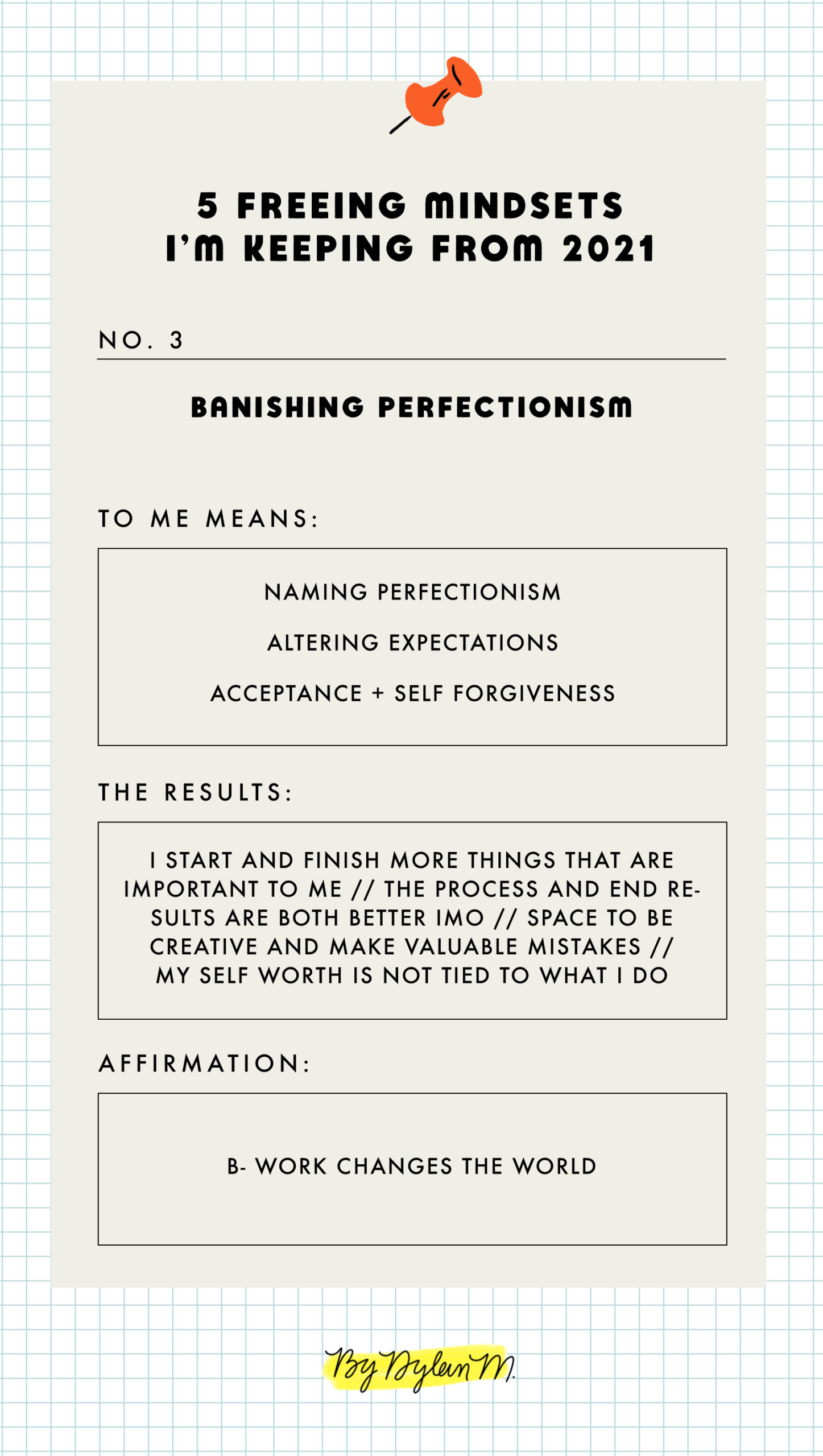
3. Banishing perfectionism
To me means:
- Noticing and naming perfectionism
- Altering expectations based on what’s reasonable, necessary, and realistic, and communicating these expectations clearly to those involved
- Lots of acceptance and self forgiveness
These can look like:
- Naming: I was procrastinating beginning making quilted stockings for two good friends of mine, and a little baffled by it because I really wanted to make them. Whenever I had a pocket of time suitable for beginning, my head would come up with any reason for why it wasn’t a good time to work on them: “I need to pick the fabric, I need to pick fabric they’ll love, I need to plan it out, I need to read the pattern again, I need to look at examples” etc etc etc. Those are the thoughts of perfectionism – I can’t pick fabric now because I need to pick the perfect fabric, I can’t start now because I need a perfect plan so I don’t make any mistakes or waste any time. As soon as I realized perfectionism was speaking to me, I reminded myself there are no perfect quilted stockings, and that beginning could be as easy as online fabric shopping (fun!) – so I started there. I used the information I had in the present moment and trusted myself to pick fabric for my friends’ stockings.
- Altering: To continue the above example, I realized I was expecting myself to make two ultimate keepsake stockings that would perfectly capture each friends unique personality and be well-loved and used forever. Whoa. In reflection it felt unreasonable, and actually kind of pompous to think I could do or control that. And that was my default expectation! I decided that the real goal was to simply finish two patchwork stockings, made from fabric choices that seemed like a good and cute fit in the moment, with a pattern that was easy to follow, and to have at least a little fun in the process. Much more reasonable, necessary, and realistic. And fun. And doable.
- Acceptance: Naming perfectionism, or realizing my expectations are high by default doesn’t make lowering them any easier or comfortable. I still want perfect stockings that mean the world to my friends, with perfect fabric choices and perfect points all lining up, but at the end of the day that desire wasn’t actually about my friends or the stockings, it was about my feelings of worthiness. The truth was my friends would love any stocking I sewed together for them, and so any attempts to hit that perfect bar aren’t for them, it’s for protecting my own feelings. And so the medicine for this perfectionism, that still seems desirable and attainable even after the illusion has been busted, is acceptance. Forgiving myself for disappointing myself. Accepting that my big powerful beautiful brain may always envision the biggest and the best, and I may always always always fall short of it, AND I’m still enough.
The result:
- As much as I don’t like to promote productivity as a blanket value, the truth is this shift has helped me start and finish way more things that are important to me and/or enrich my life in some way
- The end result is virtually just as good as the assumed perfect version, for way less time and drama (maybe even arguably better, see next bullet point)
- With so much less pressure to be perfect, my brain has space to be creative, make valuable mistakes, and learn from the process
- My self worth and self esteem are not reliant on what I do or don’t do
- I’m more accepting of imperfection//less expectant of perfection in others
Related affirmation:
- B- work changes the world
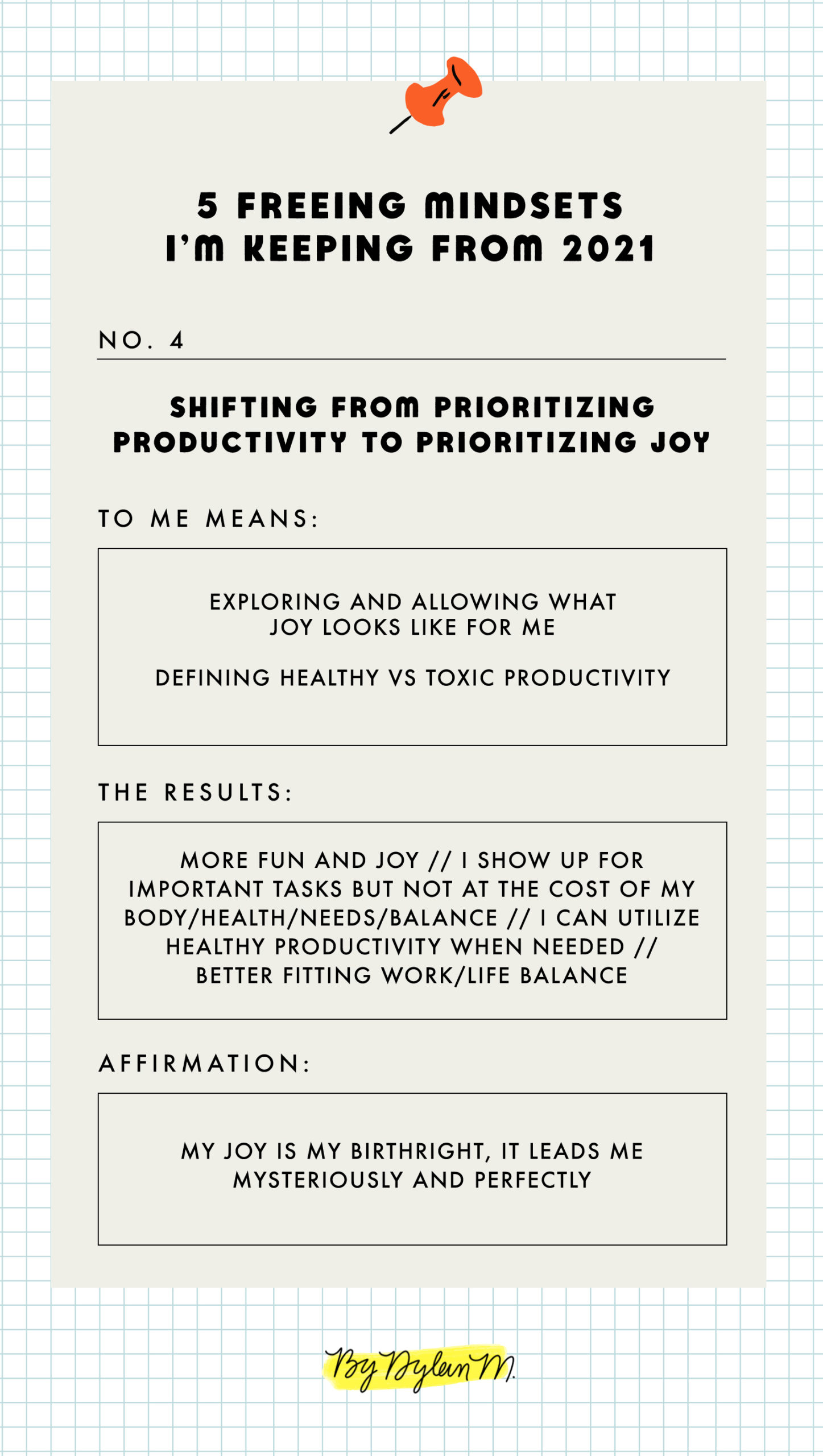
4. Shifting from prioritizing productivity to prioritizing joy
To me means:
- Noticing, exploring, recognizing, naming, and allowing what joy is for me
- Defining for myself what healthy versus toxic productivity looks like
These can look like:
- Naming: According to society, joy is sunshine, the color yellow, laughing children, and jumping in the air. As someone who loves grey, rainy days, wearing black, avoiding children, and sitting very still, I wrongly assumed joy was not for me. Joy is for everyone, I just needed to see, feel, and accept that what brings me joy may look very different from other people, but that doesn’t mean I don’t deserve to have it. Some things that bring me joy: wild animal sightings, being alone, singing out loud, wearing all black, doing my makeup, wrapping a gift, watching Real Housewives, reading celebrity gossip, reading books, helping a stranger, sauteeing garlic and mushrooms, leaving big tips, etc.
- Healthy/Toxic productivity example: Let’s say it’s the end of the work day and I haven’t completed the task I wanted to complete today, my choice is to keep working on it until it’s completed, or stop working now and adjust the deadline/timeline. Neither option is inherently OR consistently right or wrong in my eyes, it all depends on the moment. Healthy productivity could look like: checking in, realizing I still have energy and focus for this project, and determining that continuing to work won’t jeopardize meeting any of my main needs (for rest, food, movement, etc); with all those boxes checked, continuing to work may be a wonderfully productive thing to do for myself. Healthy productivity could also look like: checking in, realizing my energy and focus is drained, and deciding to meet my other needs so I can better return to the work another time. Toxic productivity would look like: working until the task is finished regardless of my energy levels, focus, or other needs. Without even checking to see the cost of continuing to work, I plow ahead for the sake of ‘getting it done.’
The result:
- Maybe obvious but whoa my life is way more fun and joyful
- I still work on and complete important tasks, but not at the cost of my health, body, time, or emotional balance
- I’ve learned so much about myself, and have surprised myself with what brings me joy
- My work is more engaging and I show up for it more easily; this isn’t magic, it’s the result of intentionally choosing tasks that align deeply with what is important to me, and enforcing the boundaries necessary to keep my space open, safe, honest, and reasonable.
- I’m able to utilize healthy productivity when I desire to, especially with necessary tasks that are decidedly unenjoyable (looking at you taxes, putting away laundry, and family phone calls)
- Better fitting work/life balance
Related affirmations:
- I can trust my joy
- My joy leads me mysteriously and perfectly
- My joy is my birthright
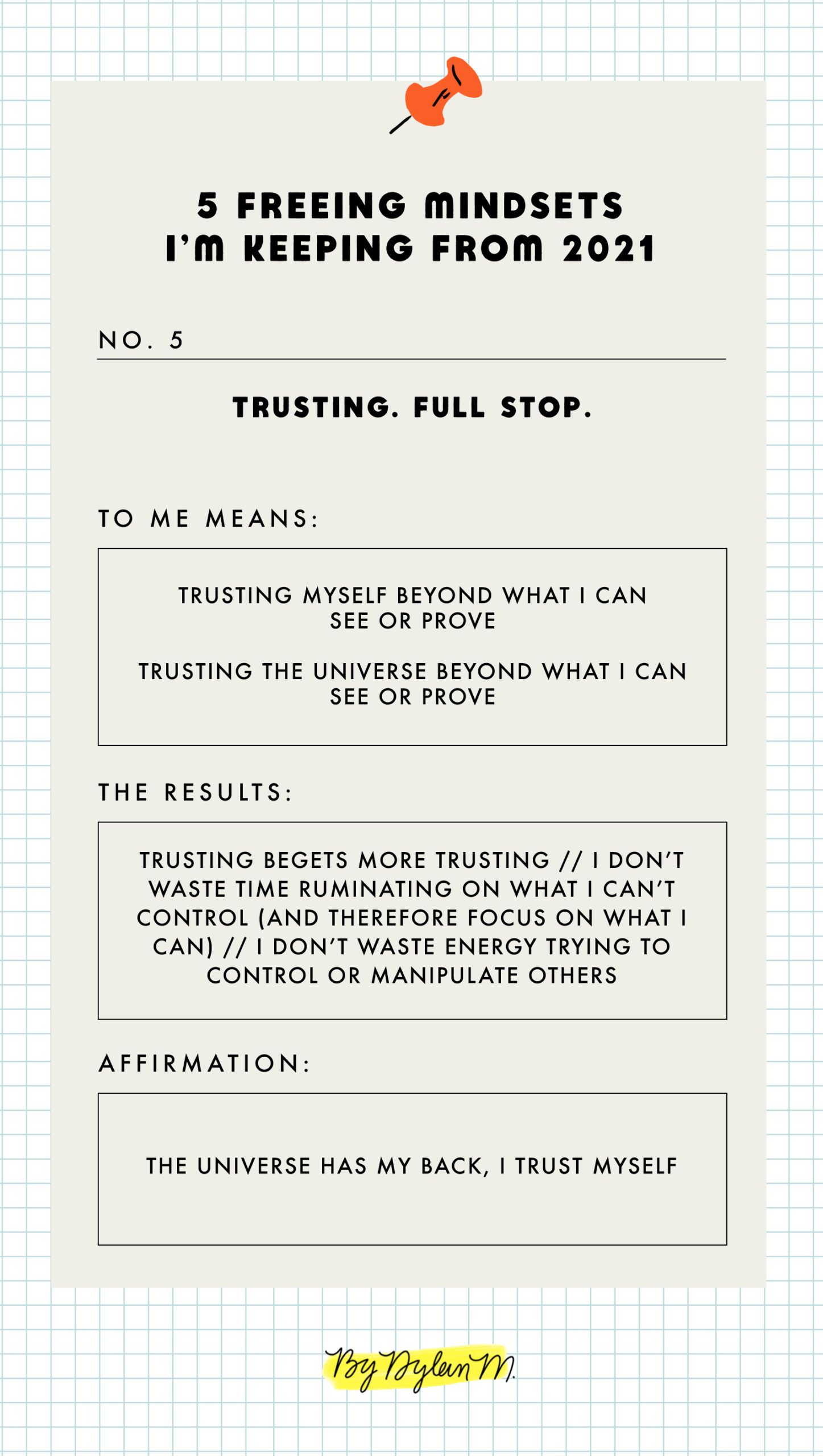
5. Trusting. Full Stop.
To me means:
- Trusting myself and my abilities beyond what I can see or prove
- Trusting the universe/God beyond what I can see or prove
Can look like:
- Myself: Beginning a podcast because my intuition keeps pinging on it, even though I’m afraid I’ll be ridiculed, or worse, not add anything of value to the conversation. In this case I trust my intuition/curiosity more deeply than the fears my rational brain can come up with
- God: Sitting on an airplane before take off, breathing deeply and successfully calming any anxious nerves, because I trust that if I’m meant to go down on that airplane, then I’m meant to go down on that airplane, and anxiety isn’t going to save me now (I want to point out that it doesn’t even matter if I’m technically right or not, the point is trust in The Universe serves up much better lunch to me (calm breathing, looking out the window, taking a nap) than anxiety can (ruminating, racing pulse, living in my brain, cortisol).
The result:
- Kind of meta, but trusting begets more trusting. It’s pretty cool. (It’s very cool actually)
- I don’t waste too much time ruminating over things I can’t control, helping me focus on what I can
- I don’t waste my energy thinking I can change or control others; I allow them the dignity of following/trusting their own path, just as I appreciate the dignity to follow mine
Related affirmations:
- The universe has my back
- I trust myself in each moment
- I have my back even when my shadows, flaws, and mistakes show
I hope some of this resonates with you, and that you leave behind whatever doesn’t. Happy New Year!
Photo by Becca Tapert on Unsplash


Hey, Dylan!
This juuuuuust might be one of my favorite blog posts from you. This is pure GOLD, my friend. Thank you for sharing your insights and experiences, Dylan. This stuff right here…well, it is certainly book worthy, too. Juuuuuust sayin’… You have really tapped into some relatable wisdom. Sending you my love.
Thank you so much Tina! Hope you’re able to implement even a sprinkle of this into your life for the better <3
Hi Dylan! I read this entire post and wanted to comment to say that I feel so much of this with you. I feel like the theme of trust is one I haven’t come to on my own, but wow it certainly does circle back to anxiety (how our brains will trick us into thinking they KNOW the future) and perfectionism (trusting that we are enough, just as we are). Recently I’ve been thinking a lot about expectations, both of myself and of the life I see for myself; how putting so much time/weight in keeping expectations really robs us of the present moment. I think incorporating the idea of *trusting* that I’m capable and *trusting* that I’ll find my way no matter what is really helpful. I’m striving to learn as much as I can about surface pattern design from artists I admire in the hopes of turning my life in a new direction and one that’s more authentic to me, but it is a nice reminder that we’re all human here with our own struggles, strengths, and things we want to be better at. (Gosh, I think I actually exhaled when I read the affirmation “the universe has my back”!)Thank you for this post (and for your Skillshare classes)!
Ahh thank you for these thoughts my friend <3
This blogpost is so helpful, kind and encouraging, just what I needed. Thank you for taking your time with it!
Love to hear it, thank you Kaisa!
Wow, this really moved me. Thank you so much for sharing your wisdom!
thank you for reading, Sophia! <3